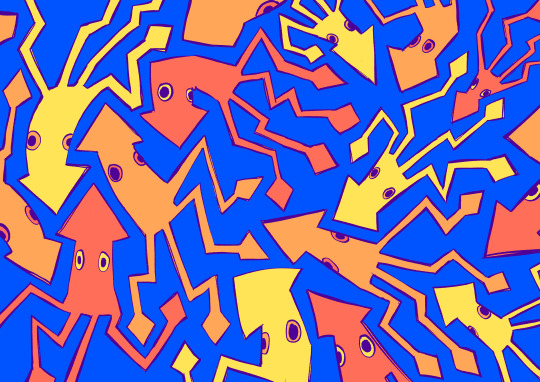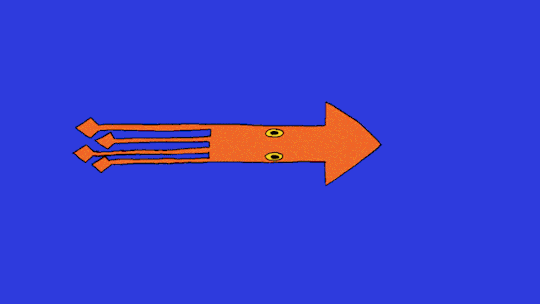Hi, I'm Alice. I started this blog mostly as a joke with some of my friends. I didn't expect to fall so deeply in love with these beautiful little cephalopods. Let's all appreciate them together! :)
Don't wanna be here? Send us removal request.
Text

A robust clubhook squid (Onykia robusta) washed up at Dutch Harbour, Alaska, USA.
This approximately 10ft long specimen was photographed and then safely relocated back to the ocean, still alive.
by Andrew Bleiman
4K notes
·
View notes
Text
Round 3 - Cephalopoda - Myopsida




(Sources - 1, 2, 3, 4)
Order: Myopsida
Common Name: “Myopsid Squids” or “Coastal Squids”
Families: 2 - Australiteuthidae and Loliginidae (“pencil squids”)
Anatomy: well-developed internal shell; eight short arms and two longer, clubbed tentacles ornamented with simple suckers; lack a secondary eyelid, instead covered by a transparent corneal membrane; communicate using a variety of color, shape, and texture changes
Diet: crustaceans, small fish, other mollusks
Habitat/Range: coastal waters worldwide, generally feeding on or near the ocean floor
Evolved: around the Eocene

Propaganda under the cut:
A Loligo fossil known from the Oligocene of Russia, is the earliest true squid known from a complete body fossil.
The Atlantic Brief Squid (Lolliguncula brevis) is the only cephalopod known to tolerate brackish water, venturing into the Chesapeake Bay.
Some cephalopods are able to fly through the air for distances of up to 50 metres (160 ft)! They can achieve these ranges by jet-propulsion, squirting water from their funnel even while in the air. The Caribbean Reef Squid (Sepioteuthis sepioidea) (image 1) has been observed spreading its tentacles out in a circle to guide its flight. This behavior is presumably for avoiding predators and/or for saving energy during migrations.
Most cephalopods are colorblind, even though they use colors, patterns, and flashing to communicate with each other. They do this through nervous control of their chromatophores, as well as cells such as iridophores and leucophores reflecting light from the environment. Caribbean Reef Squids can even send one message via color patterns to a squid on their right, while they send another message to a squid on their left, splitting their color pattern lengthwise down their body. They may do this by sensing light levels directly through their skin, rather than their eyes, utilizing photosensitive molecules called opsins. They may also be able to utilize chromatic aberration through their oddly shaped pupils.
309 notes
·
View notes
Photo

Meet The World’s Smallest & Weirdest Squid, Idiosepius - https://reefs.com/2017/10/06/meet-worlds-smallest-weirdest-squid-idiosepius/

98 notes
·
View notes
Text
Round 3 - Cephalopoda - Bathyteuthida




(Sources - 1, 2, 3, 4)
Order: Bathyteuthida
Common Name: “deepsea squids”
Families: 2 - Bathyteuthidae and Chtenopterygidae
Anatomy: internal shell; eight short, webbed arms and two long tentacles; tentacle pockets in the head and small suckers on the buccal supports; lack corneal membranes covering their eyes; bioluminescent
Diet: unknown
Habitat/Range: scattered throughout the worlds oceans, between 500–2,000 m (1,600–6,600 ft) deep; Chtenopterygidae rises near the surface at night
Evolved: around the Early Devonian

(source)
Propaganda under the cut:
In 2012, a mother Bathyteuthis berryi (image 1 and gif above) was seen holding onto and brooding her eggs in the open water column. This is unusual for squids, which will usually either attach their eggs to a surface or release thousands of them into the water column. Brooding seems to be an adaptation for Bathyteuthis berryi, which lives deep in the open water with no surfaces to attach eggs to, and with food limitations that don’t allow for the high energy cost of developing thousands of eggs. This also allows the mother to control the depth, salinity, and water temperature her eggs develop in.
The Deepsea Squid (Bathyteuthis abyssicola) (image 4) has large photosensitive vesicles just behind the eyes which appear to detect bioluminescence. These photosensitive vesicles are among the largest known in any cephalopod.
Due to their habitat and reclusive nature, not much is known about these squids
230 notes
·
View notes
Text
Quality time with a squid mum 🦑
For decades, marine biologists assumed that all squids laid their eggs in clusters on the seafloor, where the eggs developed and hatched without any help from their parents. However, MBARI scientists discovered that some female deep-sea squid, like this Gonatus onyx, brood their eggs by carrying them between their arms until the young hatch and swim away. Gonatus females will have approximately 2,000 to 3,000 eggs in a sheath between their arms for as long as nine months. During this time, they are unable to feed and must rely on stored fats from previous meals. This observation of the first known parental care behavior by squid was also an important discovery made possible by the use of MBARI’s remotely operated vehicles.
4K notes
·
View notes
Text
youtube
FIRST LIVE COLOSSAL SQUID SIGHTING IN HISTORY
247 notes
·
View notes
Text
something I love about the world is that no matter how obscure or uninteresting and animal is, there's always least one person who cherishes it and loves it so much
for example, I have a strong obsession with this random squid called sandalops melancholicus


this is probably the most boring and generic cranchiid squid, but it is so beautiful to me in a way that I can never describe

every other cranchiid squid has something cool going for it; cranchia scabra has weird denticles kinda like a shark, leachia has a ring of lights around its eyes unlike any other squid, the colossal squid is the colossal squid etc.
but sandalops? sandalops doesn't have anything cool going for it. it either loses most of its suckers if it's a male or loses its tentacles if it's a female
but I still love it so much. I don't fully know why, but it is just so amazing and relatable

don't worry sandalops, you're better than all of them
2K notes
·
View notes
Text
Enjoy the beauty of squid in nature Stunning colors
youtube
21 notes
·
View notes
Text
squidward, meaning "in the direction of squid"
18K notes
·
View notes
Text
Imagine yourself submerged in the prehistoric ocean. There are no fish, instead the only life forms consist of feather-like sessile organisms that sit on the seabed, filtering the current. The early organisms that evolved out of this, such as Jellyfish and Starfish, had radial anatomy. Their body structure entails a central axis from which you can split everything else. These bodies are simple, not designed for active mobility, lacking a ‘forwards’ or ‘backwards’. They didn’t even have eyes, instead interacting with and responding to the world via photoreceptive cells. What emerged from this were two developments: the evolution of complex eyes and the emergence of bilateral anatomy in early vertebrates and arthropods. In contrast to radial anatomy, bilateral anatomy entails an organism that can be split down the middle with rough symmetry. This is to say that they are built for direction. A body that is built for mobility entails significantly more complex behaviour behind its operation. Behaviour, in this sense, also becomes significantly more directed. These creatures now living in the ocean or on the sea-floor now begin to directly interact with one another. The mechanisms facilitating this interaction become pretty apparent in the fossil record; eyes, claws and antennae. The evolutionary consequences of this are the emergence of a complex nervous system alongside the presence of predation and, as Godfrey-Smith puts it “[From this point on] The mind evolved in response to other minds”.
555 notes
·
View notes
Text
I know it's unfair vilification and stuff but it's also a lot of fun to see old media and stuff where people were SO scared of big animals like lions, sharks, crocodiles and wolves were fully expected to just come and eat you the moment you stepped into their territory. In older media we also made that assumption about gorillas and in still older we thought it'd be whales. But some animals that will actually fuck you up got left behind. Boars will kill you and eat you. They're way more likely to do so than any of those other things actually. Hippos, obviously, got off like bandits always being depicted as cute and dopey. And then there's the squids. Not giant kraken size squids. The eight foot squids that hunt in packs and will fuck you up if you fall in the water at night. I can't BELIEVE people slept on that. It's like all they cared about were the huge deep sea ones we never see. The medium size wolf pack squids were right there.
47K notes
·
View notes
Text
236 notes
·
View notes
Text
Mystical, magical, mystery squid 🤩
The long-armed jewel squid (Stigmatoteuthos dofleini) has eyes that are very different in size and structure. Like their strawberry squid cousins, these cockeyed squid have developed eyes that are highly modified to find food, avoid being eaten, and find a mate with maximum efficiency in a light-limited environment. Cockeyed squid are born with two identical eyes, just like any other squid hatchling, but as they develop into juveniles, the left eye begins to surge in size. By the time they reach adulthood, the left eye can be more than twice as big as the right one! It also develops a semi-tubular structure and often has a striking yellow lens. Together, this unlikely pair helps the squid hunt for food in the ocean’s twilight zone. The big left eye looks upward to spot shadows cast by prey in the dimly lit waters above. The eye’s tubular shape helps collect as much downwelling light as possible. Often, this eye has a yellow lens to see through the luminescent camouflage of its prey. The squid’s right eye is small and looks downward. This eye searches for flashes of bioluminescence produced by prey or predators lurking in the darker waters below.
175 notes
·
View notes
Text
Got blood? Don’t worry, the vampire squid doesn’t eat that. 🧛 This spooky season, see this cephalopod, and other fascinating deep-sea dwellers, in Opulent Oceans—a free exhibition that highlights the integral role scientific illustration has played in undersea exploration and discovery.
369 notes
·
View notes


